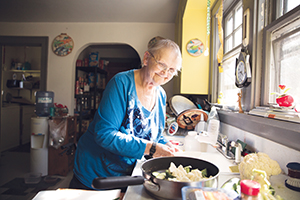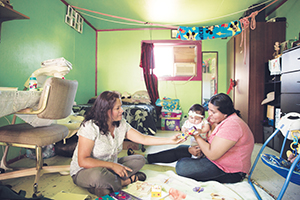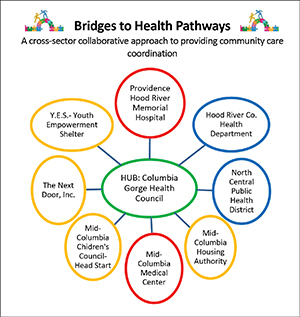Health and social service providers team up to improve wellness of individuals and groups in Pacific Northwest
By KEN LEISER
An elderly woman faced foreclosure because of unpaid property taxes in rural Hood River County, Oregon. A county commissioner told the county's health department director about the risk of eviction. The health department passed word to the nonprofit Columbia Gorge Health Council.
Among its many services, that council's Bridges to Health Pathways program coordinates access to health care and other services for vulnerable people in the sprawling Columbia Gorge region about 60 miles east of Portland, Oregon, said Coco Yackley, the council's executive director.
Columbia Gorge encompasses five counties in north-central Oregon and two counties in south-central Washington state that all straddle the Columbia River. The rural region is defined by the extremes of wealth and poverty. Its population of about 84,000 is spread over 10,284 square miles — an area roughly the size of Connecticut.

June Husted cooks a meal with fresh ingredients purchased with her Veggie Rx vouchers. Providence Hood River Memorial Hospital, other health providers and local farmers in the Columbia Gorge region in Oregon and Washington launched the program.
Josh Kohanek /© Robert Wood Johnson Foundation
Bridges to Health assigned a community health worker to assist the woman, who'd recently been widowed and was socially isolated. The community health worker reached out to local philanthropists, one of whom paid the woman's back taxes just 48 hours before the deadline in May 2018, buying her time to stabilize her housing situation.
But more hurdles lie ahead.
The widow, who was in her 70s, hadn't been to doctor in 13 years and was hesitant to seek care. To calm her apprehensions, the community health worker went with the woman to an initial medical appointment, said Suzanne Cross, senior program manager for Bridges to Health. With the encouragement of the community health worker, the woman took steps to break through her isolation. She reestablished connections with her church, and began participating in church-sponsored gatherings.
The community health worker helped the widow tick major projects off her must-do list. For example, the woman couldn't get homeowner's insurance because her roof was in disrepair; but, after a snakeskin was found in the attic, roofers couldn't safely start work until an exterminator was called to investigate. (No snakes were found.)
Cross said the community health worker located community programs to pay for the exterminator's inspection and the new roof.

Community health worker Vitalina Rodriguez, left, interacts with Dalia Castillo and her baby, Altana Delgado, at the family’s home in the Columbia Gorge region east of Portland, Oregon. Rodriguez works for The Next Door Inc., one of the organizations that collaborates in the Bridges to Health Pathways.
Josh Kohanek /© Robert Wood Johnson Foundation
Yackley said collaboration among health and social service providers is the key to efforts to bridge health disparities in a region where one out of five residents report having insufficient food.
Sum of its parts
Brought together by an Oregon law passed in 2012 aimed at addressing health disparities, health care organizations — including Providence Hood River Memorial Hospital — and social welfare activists have taken collaboration to a level that has not been seen before in the Gorge. The Columbia Gorge Coordinated Care Organization they created has partnered on community health needs assessments and care, services and programs to address service gaps and priorities identified in those assessments.
The Columbia Gorge Health Council governs the coordinated care organization, allocating funding and convening partners in efforts to improve the health of the region.
In 2016, the Robert Wood Johnson Foundation recognized the power of that collaboration with its Culture of Health Prize. (The national competition is held annually to recognize communities that work together to improve health care.)
So far, the Columbia Gorge Health Council's partner agencies have developed 40 new initiatives and trained 100 community health workers, who are employed by agencies throughout the Gorge in both health care and social services. Many of the community health workers provide outreach to poor Latino farmworker families who tend the region's orchards. (The region is a major producer of peaches, apples and cherries.) Cross said a grant writer whose salary is paid by Providence Hood River has brought in over $10 million to support those initiatives to improve health and wellness in the region.
"To me, the real gem in all this work is just this culture of working together," said Mark Thomas, chief mission officer and spiritual care manager for Providence Hood River.
The 2012 state law laid the foundation for 16 coordinated care organizations that would operate across the state as part of the state's Medicaid model. In addition to a governing council, each coordinated care organization also is guided by a community advisory council that, by Oregon statute, includes Medicaid recipients as voting members. The organizations are tasked with identifying the most pressing health needs of their respective regions, prioritizing their efforts and implementing action plans to respond to the community needs.
Level field
The Columbia Gorge Coordinated Care Organization kicked off its first health needs assessment at the Corner Pocket Bar in Lyle, Washington, a town picked for its central location. Thomas stressed the importance of a meeting place that was convenient to all, in part, to make clear that no one institution "was so big and important that everyone needed to come to us."

A central council coordinates the activity of partner organizations in the Bridges to Health Pathways program.
Under the egalitarian structure, collaborators agree to meet the most stringent regulatory requirements of any member. For example, Oregon law requires coordinated care organizations to complete a needs assessment every five years. But Providence and the three other hospitals in the Columbia Gorge also must assess community needs every three years to comply with federal regulations, so, to prevent redundancy, the collaborative follows the three-year timetable.
Following its first assessment, the council determined that some of the most pressing community concerns included insecurity over food, jobs, transportation and housing. There was a need to improve access to dental and mental health care and to better coordinate across health care and social services.
A large segment of the population reported suffering food insecurity, and addressing hunger and malnutrition was identified as a priority.
Coalition partners, including Providence, other health providers and local farmers established The Gorge Food Coalition and that group launched a Veggie Rx program. Qualifying patients get monthly vouchers to buy fruits and vegetables. The program "blew up much faster" and benefited more people than originally forecast," said Paul Lindberg, a collective impact health specialist with the United Way of the Columbia Gorge. (Lindberg is paid by Providence to write grants for community organizations.)
The Gorge Grown Food Network, which runs the Veggie Rx program, began a grant-funded voucher program in June 2018 for pregnant women enrolled in the Special Supplemental Nutrition Program for Women, Infants and Children. The women can select produce at farmer's markets during the season to supplement their WIC benefits. During the winter months, participants can opt to have a produce box delivered to their doorsteps twice a month.
Columbia Gorge is now on its third health needs assessment, and is continuing to refine its information gathering process. Survey questions are written in English and Spanish. Cross said questions have been rewritten to ensure they are clear to people who read at a sixth-grade level.
Thomas said the power in collaboration is that the collective energy and impact is greater than the sum of siloed efforts to aid the vulnerable. "In a personal way," he added, "I feel the strength of the sense of mission in our community as strongly as I feel it in the Catholic organization I work with."